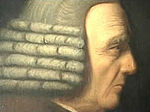


Web: www.chinaclayhistory.org.uk
Pharmacist who discovered china clay
William Cookworthy found china clay in Cornwall, and developed a way to process it into fine porcelain pieces.
The St. Austell deposits have now been worked for over 200 years and are the largest in the world. Around 120 million tons of china clay have been produced since William Cookworthy's first discovered it at Tregonning Hill in 1746, but reserves are sufficient for at least another hundred years.
William Cookworthy was born in 1705 and he was the son of a Quaker weaver from Kingsbridge in Devon. His father died in 1718 and the family were quickly reduced to a state of poverty. He became an apprentice to Silvanus Bevan, a Quaker chemist and druggist in London. William was so poor that he could not afford the coach fare from Devon to London, and had to walk the whole 200 miles.
In 1726, Bevan decided to start a wholesale pharmacy business in Notte Street, Plymouth, and William took a job there. By 1735 Cookworthy and Bevan were partners. In that year he married Miss Sarah Berry. Ten years later he bought out his partners but Sarah's unexpected death that year left him with a family of five girls to bring up on his own. His brother, Philip, joined him as a partner and the business became Messrs William Cookworthy and Company, the Bevans having by now left the scene.
The Cookworthys' apothecary shop,continued as a pharmacy until 1974 when the last proprietor retired. The business flourished, supplying merchant ships in the busy port. He is said to have entertained Captain Cook and Joseph Banks before they sailed in Endeavour to Otaheite, in the Pacific Ocean, in 1769.
William Cookworthy happened to read a description of Chinese porcelain manufacture written by a Jesuit missionary in the 1740's. This accidental find, aroused his curiosity, which was further enhanced when he was visited by businessmen from Virginia with samples of Virginian clay and porcelain in 1745.
They wanted him to import Virginian clay and make porcelain in England. Cookworthy decided to look for these minerals in England, and he found them locally in Cornwall. They were known as Moorstone or Growan, and Growan clay. Cookworthy began to experiment with these ingredients. However, it took him until 1768 to file a patent specification, and be granted Patent number 898 for "Making porcelain from Moorstone, Growan and Growan clay."
At that point in time, English potters were only able to produce what was known as 'earthenware'. Porcelain was imported from China, where the clay used was known as 'kaolin'. But in 1746 Cookworthy discovered china clay at Tregoning Hill near Helston, where it was known as "moorstone". He noticed miners repairing the furnaces with clay at the Great Work Mine, and found out where they were getting it from. Having found that it was suitable for making porcelain, he leased some clay pits on the Hill. He shipped the clay from Porthleven to Plymouth, where he determined the best way to turn it into porcelain. By December 1766 he had set up a small factory.
The clay from Tregoning Hill however contained dark specks of mica, which detracted from a top quality finished product. During 1768 better quality clay was found on land owned by Mr Thomas Pitt in St. Stephen, near St. Austell. Mr Pitt, who was to become Lord Camelford in 1784, invested money in the process and became a partner with him in the Plymouth China Works in Plymouth.
They primarily made decorated tea services, jugs and vases. However, the business was not making a profit in Plymouth, and it amalgamated with a pottery in Bristol. Cookworthy made his cousin, Richard Champion, his manager of "William Cookworthy and Company." In 1774, Cookworthy sold his interest in the business and patent to Champion. Champion continued to buy the ingredients for the porcelain from Lord Camelford, and paid a royalty to Cookworthy.
When Richard Champion tried to renew Cookworthy's patent in 1777, Josiah Wedgewood and other potters in Staffordshire raised objections. The patent formula was upheld, but the actual use of the china clay was released so that ceramic products could be made from it provided that the formula was not infringed. The cost of the legal battle crippled the Company and Richard sold the formula in 1782 to the New Hall Porcelain Company, which had been formed by the Staffordshire potters. They continued to produce porcelain until around 1810, when bone china became available.
Cookworthy also helped Eddystone lighthouse builder John Smeaton with the development of hydraulic lime, a form of mortar which will set under water and was essential to the successful building of the lighthouse.
William Cookworthy died on Tuesday October 17th 1780 and was buried in the family vault in the Westwell Street Burial Ground. At that time the wholesale business in Notte Street passed to his young brother, Benjamin.
The earliest known extant piece of Cookworthy's hard-paste porcelain is now in the British Museum; a blue decorated mug bearing the Arms of Plymouth and the inscription "14th March 1768 C.F." - presumably the initials mean "Cookworthy fecit" (made it).
St. Austell Roche Par St.Dennis St. Stephen
Cornwall's History Famous Cornish People Wheal Martyn Cornwall's China Clay Industry